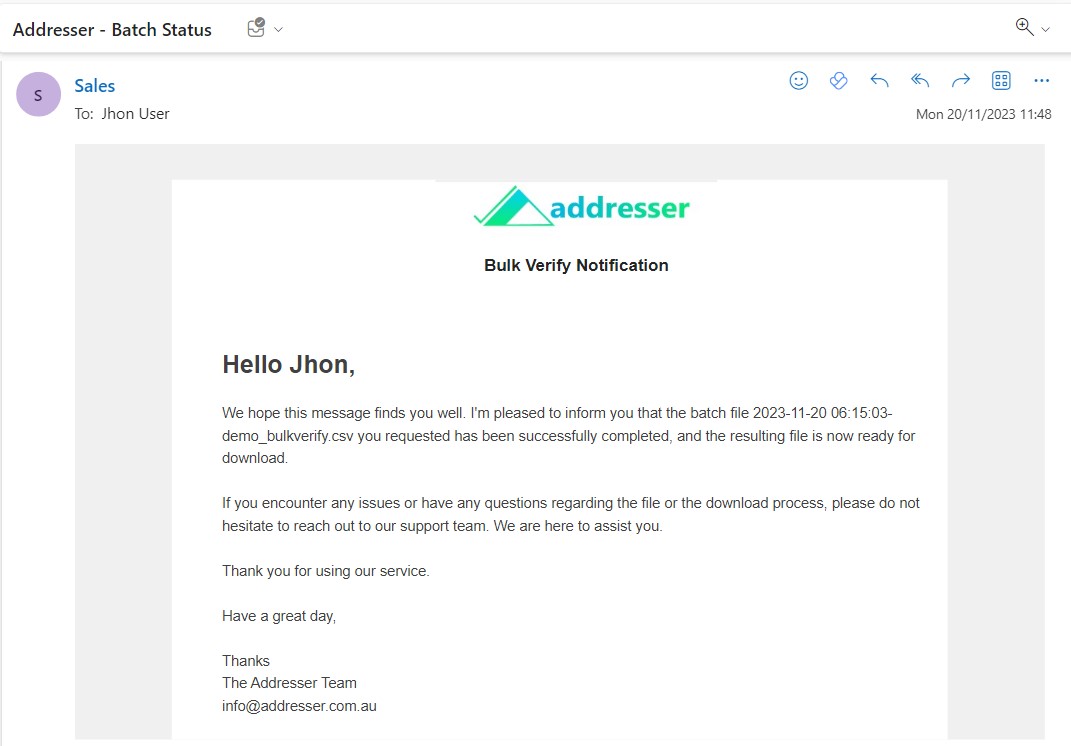Overview
This document provides detailed step-by-step instructions for using the Addresser self-service bulk cleansing. The self-service bulk address validation service requires an address CSV (Comma separated value) file.
The pre-requisite of the bulk address cleansing is subscription of the “Business” plan from our pricing page.

We have flexible pricing options starting from 500 lookups per month through to 150,000 lookups per month.
Please note the trial plan (Business 500 lookups/ 7 days) cannot be used for your production data cleansing.
Input Data Format
The self-service bulk address validation service requires an address CSV (Coma separated value) file. Each record or line item should have full address stored in one single column and unique identifier in another column.
Addresser system accepts only UTF-8 encoded files only.

A CSV can also be created using Microsoft Excel, however do save it as CSV format only as Addresser accepts only CSV files.
NOTE: Ensure your CSV doesn’t additional include commas (,) in the address field. This is the most common mistake we found where the systems cannot match the header information with additional CSV causing the data format mismatch between different rows of data.
Dashboard
Register for “Business” plan that suits your volumes per month, you will be prompted to create username and password that you will need to access Addresser dashboard to upload the files for bulk cleansing. This document assumes registration is completed and user has access to the dashboard.
Login
Using the registered username and password login to the dashboard via the secure Signin web page.

Navigate to Bulk Validation

From the left-hand navigation bar select “Bulk Validation”, the bulk validation page shows up with two tabs at the top – “File Upload” and “Recents”.
Upload the CSV
Select a plan from the “Select Plan” drop-down on the “Bulk Validation” page.
Click the “Add CSV” button on the “Bulk Validation” page to select the file to upload.

Check “Has header” checkbox if your CSV has header. Also take the opportunity to check the row count and number columns the system identified from your file.
Click the “Next” button to go to next step of the file upload.

The next page show sample record (first row) from the CSV file uploaded. You need to choose which column has the address that must be validated.
Select the address column (in this case it is INPUT_ADDRESS), and click “Upload”.

The system will show the “Recents” tab. The list of files in the “File name” column have been purposefully removed for privacy reasons.

The most recent uploaded file is show at the bottom of the table. At this stage it is in submitted. You would have received a notification email as shown below.

You will receive a second notification email confirming the bulk cleansing is completed which is when you can download the file.

Go back to the “Recents” tab on the “Bulk Validate Page”, you will see the file uploaded is now ready with all the bulk validation completed.

Click “Download” button to download the file.
Cleansed File Format
| Column Name | Description |
| CUST_ID | Column from the uploaded file, data unchanged. |
| INPUT_ADDRESS | Column from the uploaded file, data unchanged. |
| ANS_DELIVY_POINT_ID | The DPID of the validated and matched address. A value of "0" means address cannot be matched as per Australia Post AMAS Guidelines. |
| ANS_FLAT_UNIT_TYPE | Standardised flat unit type. |
| ANS_FLAT_UNIT_NBR | Standardised flat unit number. |
| ANS_FLOOR_LEVEL_TYPE | Standardised floor level type. |
| ANS_FLOOR_LEVEL_NBR | Standardised floor level number. |
| ANS_LOT_NBR | LOT number of the address if available from GNAF data. |
| ANS_POSTAL_DELIVERY_TYPE | Standardised postal delivery type (for PO Box etc). |
| ANS_POSTAL_DELIVERY_NBR | Postal delivery number (for PO Box etc). |
| ANS_POSTAL_DELIVERY_NBR_PFX | Standardised postal delivery number prefix (for PO Box etc). |
| ANS_POSTAL_DELIVERY_NBR_SFX | Standardised postal delivery number suffix (for PO Box etc). |
| ANS_HOUSE_NBR_1 | Address house or property number. |
| ANS_HOUSE_NBR_SFX_1 | Address house or property suffix. |
| ANS_HOUSE_NBR_2 | Address house or property number for ranged addresses (E.g. 10-12 George St Sydney NSW 2000) |
| ANS_HOUSE_NBR_SFX_2 | Address house or property number suffix for ranged addresses (E.g. 10-12 George St Sydney NSW 2000) |
| ANS_STREET_NAME | Address street name |
| ANS_STREET_TYPE | Standardised street type |
| ANS_STREET_SFX | Standardised Street suffix. |
| ANS_LOCALITY_NAME | Address suburb or locality name. |
| ANS_POSTCODE | Address postcode |
| ANS_STATE | Address State Name |
| ANS_GNAF_LONGITUDE | Address Longitude if available from GNAF data. |
| ANS_GNAF_LATITUDE | Address Latitude if available from GNAF data. |
| ANS_FULL_ADDRESS | Standardised single line address. |
| ANS_CORRECTIONS_APPLIED | Corrections applied to the supplied address. |
| ANS_BARCODE_4STATE_NUMBER | Australia Post standard DPID represented in 4-state barcode number. |
| ANS_MATCH_TYPE | Determines whether the matched address is to a primary address such as street address. Secondary address match pertains to specific unit number “13/59”, or other non-primary address parts such as Street number suffix. Eg. “A” in “205A” |
| ANS_MATCH_SCORE | Match score is determined based on the number of address parts matched based on the Australia Post address matching rules, for example a match score of 100 means an exact match of the input address. |
| ANS_MATCH_QUALITY | Low, Medium and High determines the confidence levels of the matched address. |

